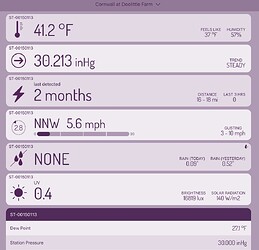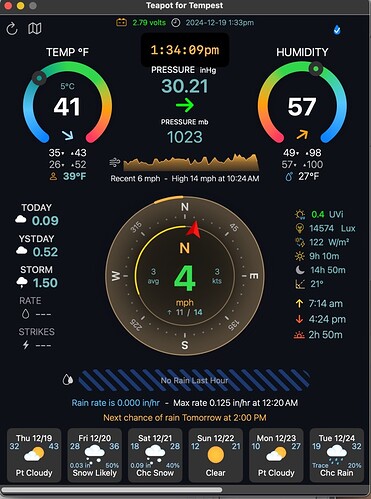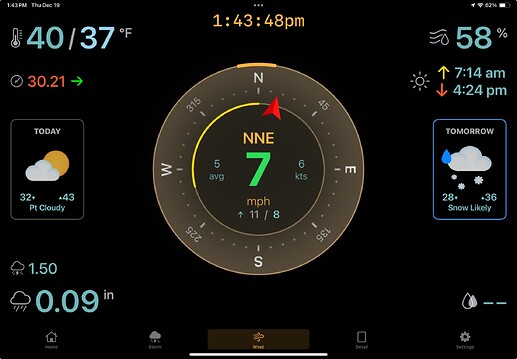The weather, and getting information about it from Apple devices, comes up occasionally on TidBITS Talk. Apps that present current conditions and accurate forecasts for a large area are out there as well.
But if, like me, you are keen enough about weather conditions in your neighborhood to install a weather sensor at your home and consult it periodically, it’s a little challenging to find equipment and software that won’t put a hurt on your wallet.
I used Ambient Weather’s wireless sensors for about a decade, but started looking for a better solution when my second sensor package, in use for less than 3 years, lost its “spinner” anemometer and stopped reporting current temperatures. It was part of a package that included a console based on (I think) Android, which was nice looking and kept good time but had a very clunky UI; and a small bridge component that relayed station data to Weather Underground.
I wanted something that had no moving parts, could provide all the readings I was getting from the Ambient sensor when it worked, and wouldn’t look monstrous on our roof. I settled on a Tempest station, which uses “haptic technology” to translate vibrations and drops on its surfaces into wind and rain data. Although the initial run of Tempest sensors was very erratic about rainfall, it has improved to the point where my readings are comparable to other, non-Tempest stations in my vicinity. This is my station:
The Tempest system fully supports xOS devices, and supports Macs through a Web interface. It links seamlessly to Weather Underground, checking off one of my other boxes, and it adds lightning detection to the sensors that were on the Ambient package.
What it doesn’t do is present the information very well. The interface is heavy on big numbers, presented in rows. Tapping on numbers gives you more granular numbers.
Ugh.
WeatherFlow does provide an API for developers, though, and after some investigating I found Teapot for Tempest. In contrast to the Tempest app, Teapot takes Tempest’s data and presents it graphically, with plenty of color that will still make sense for users with various color-sensing divergencies.
The best part for me is that Teapot has a large “wind” view that abstracts the current conditions into a large display that is perfect for a console.
Combined with a preference that keeps an iPad awake whenever the app is active, this has allowed me to repurpose my iPad Air 2 for use as a Tempest console.
In the 5 months since I installed the Tempest system and Teapot, I ran into one brick wall: 2 weeks ago I walked past the “console” and noticed it was dark. When I tried to relaunch Teapot, it failed. I wrote to Brian Milburn of 27Labs, who developed and maintains the software; he let me know that his latest update had failed on iOS 15 (which is the last version my Air 2 can run) because of resources that had been removed from the most recent release of Swift. He was pessimistic on a Friday that anything could be done to revive it. But on Monday, there was a new update that indeed restored operation on iOS 15.8. It turned out to be another development library that was the culprit.
Personally, I like apps where the developer is responsive and accessible, and Brian has been adding features as well as maintaining compatibility for older devices. I commend it to other Tempest users to present your weather station’s data in a way other (ordinary!) people can take in.
The Mac app is a one-time purchase, and the xOS apps are a single subscription for all devices. I personally think it’s a small price to pay for getting that old iPad up and running again.
(Teapot for Tempest, Brian Milburn - 27Labs; MacOS 13 and later, v 1.25, $14.99 perpetual license; iOS 16 and later, v 1.44, $0.99 monthly/$9.99 annually, Family Sharing supported)
(I have no connection with Brian other than being a very happy user!)


